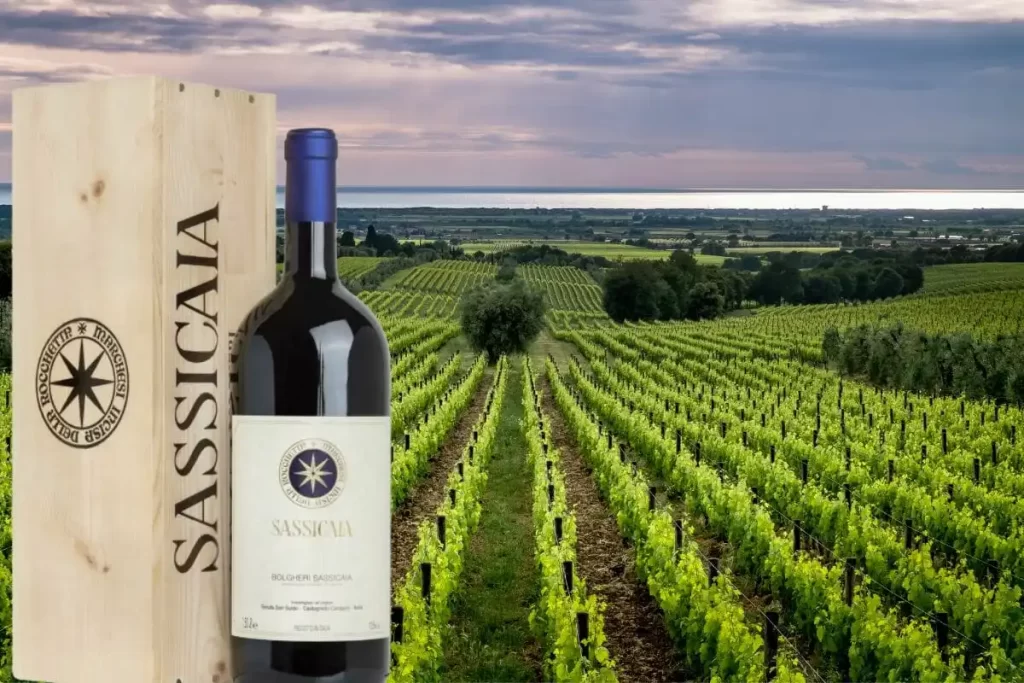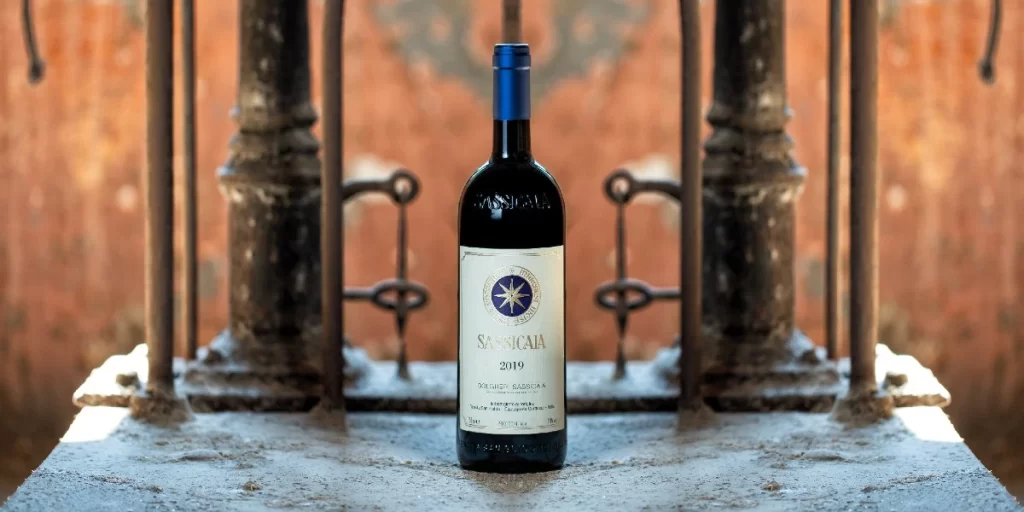Sassicaia: Italy’s Premier Super Tuscan
Located in the picturesque region of Tuscany, Italy, the Sassicaia winery has a rich and fascinating history that dates back to the 1940s. It was in 1944 that the Marchese Mario Incisa della Rocchetta, a member of the noble Tuscan family, first planted the Cabernet Sauvignon and Cabernet Franc grape varieties on his estate in Bolgheri. At the time, this was considered a bold and unconventional move, as the region was primarily known for its production of Sangiovese-based wines.
Marchese Mario Incisa della Rocchetta’s vision was to create a wine that would rival the great Bordeaux wines of France. He believed that the unique terroir of Bolgheri, with its coastal climate and well-draining, rocky soils, would be the perfect environment for these Bordeaux grape varieties to thrive. After years of experimentation and refinement, the first vintage of Sassicaia was produced in 1968, and it quickly gained a reputation for its exceptional quality and elegance.
The name “Sassicaia” is a nod to the estate’s distinctive terroir, as it translates to “the place of many stones” in the local dialect. This rocky, well-drained soil, combined with the maritime climate, creates the perfect conditions for the Cabernet Sauvignon and Cabernet Franc grapes to develop their signature flavors and aromas. The Sassicaia estate is located just a few kilometers from the Tyrrhenian Sea, which helps to moderate the temperature and provide the vines with the necessary cooling breezes during the growing season.
Characteristics and Flavor Profile of Sassicaia
Sassicaia is renowned for its exceptional quality and distinctive flavor profile. The wine is typically a blend of Cabernet Sauvignon and Cabernet Franc, with the exact proportions varying depending on the vintage. The Cabernet Sauvignon provides the wine with its bold, structured backbone, while the Cabernet Franc adds layers of complexity and elegance.
On the nose, Sassicaia displays a captivating array of aromas, ranging from ripe, dark berries like blackcurrants and blackberries to more subtle notes of cedar, tobacco, and spice. The wine’s bouquet is often described as being both powerful and refined, with a seamless integration of fruit, oak, and tertiary characteristics.
In the mouth, Sassicaia is known for its exceptional balance and complexity. The wine typically exhibits a full-bodied, velvety texture, with well-integrated tannins that provide structure and longevity. The flavors mirror the aromas, with layers of ripe, dark fruit, complemented by nuances of leather, vanilla, and graphite. The finish is long and persistent, leaving the palate with a lasting impression of elegance and sophistication.

The Importance of Terroir in Producing Sassicaia
The terroir of the Sassicaia estate is a crucial factor in the wine’s exceptional quality and character. The unique combination of soil, climate, and microclimate in Bolgheri creates the perfect conditions for the Cabernet Sauvignon and Cabernet Franc grapes to thrive.
The estate’s soils are predominantly composed of calcareous clay and gravel, with a high proportion of stones and pebbles. This well-draining, rocky terrain forces the vines to dig deep into the soil, seeking out the necessary nutrients and water. This, in turn, results in lower yields but more concentrated and flavorful grapes.
The maritime climate of the Bolgheri region also plays a significant role in the development of Sassicaia’s flavor profile. The proximity to the Tyrrhenian Sea helps to moderate the temperatures, providing the vines with a cooling influence during the hot summer months. The sea breeze also helps to dry out the grapes, concentrating the flavors and acidity.
Additionally, the estate’s unique microclimate, with its gentle slopes and exposure to the sun, allows for optimal ripening of the grapes. The Cabernet Sauvignon and Cabernet Franc varieties thrive in these conditions, developing their signature flavors and achieving the perfect balance of sugar, acidity, and tannins.
Notable Vintages of Sassicaia
Over the decades, Sassicaia has produced numerous exceptional vintages that have cemented its reputation as one of the world’s finest wines. While each vintage is unique, there are several that stand out as particularly noteworthy.
One of the most legendary Sassicaia vintages is the 1985. This wine was a groundbreaking release, as it demonstrated the incredible potential of the Bolgheri region to produce world-class Cabernet-based wines. The 1985 Sassicaia was praised for its exceptional balance, complexity, and longevity, and it quickly became a benchmark for the Super Tuscan category.
Another standout vintage is the 1988, which is often considered one of the greatest Sassicaia wines ever produced. This vintage was characterized by its remarkable depth, structure, and concentration, with flavors that ranged from ripe, dark fruit to earthy, savory notes. The 1988 Sassicaia has aged beautifully over the years, and it remains a highly sought-after collectible among wine enthusiasts.
More recently, the 2016 vintage has been widely acclaimed as a triumph for Sassicaia. This wine showcases the estate’s ability to consistently produce exceptional quality, even in challenging growing seasons. The 2016 Sassicaia is praised for its elegance, complexity, and exceptional balance, with a long, persistent finish that lingers on the palate.
Pairing Food with Sassicaia
Sassicaia’s exceptional quality and complexity make it a versatile wine that pairs beautifully with a wide range of cuisines. As a full-bodied, structured wine, Sassicaia is particularly well-suited to pairing with rich, flavorful dishes that can stand up to its bold flavors.
One classic pairing is with grilled or roasted red meats, such as beef, lamb, or venison. The wine’s robust tannins and concentrated fruit flavors complement the savory, umami-rich qualities of these dishes, creating a harmonious and satisfying dining experience.
Sassicaia also pairs wonderfully with hearty, slow-cooked dishes, such as braised short ribs, osso buco, or beef stew. The wine’s complexity and depth of flavor can help to balance the richness of these dishes, while the food’s bold flavors can, in turn, bring out the wine’s nuanced characteristics.
For those seeking a more delicate pairing, Sassicaia can also be enjoyed with grilled or roasted seafood, such as seared tuna, grilled salmon, or roasted sea bass. The wine’s acidity and fruit-forward profile can help to cut through the fattiness of these dishes, creating a refreshing and well-balanced combination.
How to Properly Store and Serve Sassicaia
Proper storage and serving are essential to ensuring that Sassicaia reaches its full potential and delivers an exceptional drinking experience. As a premium, age-worthy wine, Sassicaia requires specific care and attention to maintain its quality and character.
When it comes to storage, Sassicaia should be kept in a cool, dark, and humidity-controlled environment, such as a wine cellar or a specialized wine refrigerator. The ideal storage temperature for Sassicaia is between 55°F and 65°F, with a relative humidity of around 70%. Exposure to excessive heat, light, or fluctuations in temperature can cause the wine to prematurely age or develop undesirable characteristics.
It is also important to store the bottles on their sides, which helps to keep the cork moist and prevent air from entering the bottle. This, in turn, helps to preserve the wine’s freshness and prevent premature oxidation.
When it comes to serving Sassicaia, it is recommended to allow the wine to breathe for at least 30 minutes to an hour before enjoying it. This allows the wine to open up and reveal its full range of aromas and flavors. Sassicaia is best served at a temperature of 64°F to 68°F, which helps to bring out the wine’s complexity and balance.

The Impact of Sassicaia on the Wine Industry
Sassicaia’s impact on the wine industry cannot be overstated. As one of the pioneering Super Tuscan wines, Sassicaia has played a pivotal role in the evolution and recognition of Italy’s winemaking prowess on the global stage.
Prior to the emergence of Sassicaia and other Super Tuscan wines in the 1970s and 1980s, Italy’s wine industry was primarily focused on traditional, Sangiovese-based wines, such as Chianti and Brunello di Montalcino. Sassicaia’s success in blending Bordeaux grape varieties like Cabernet Sauvignon and Cabernet Franc demonstrated the country’s ability to produce world-class, non-traditional wines that could rival the best offerings from France and other renowned wine regions.
The critical acclaim and commercial success of Sassicaia paved the way for a new generation of innovative, quality-focused winemakers in Italy. This, in turn, led to the proliferation of the togelon category, which has become a source of immense pride and prestige for the Italian wine industry. Today, Sassicaia is considered a benchmark for the Super Tuscan style, and its influence can be seen in the countless high-quality, Cabernet-based wines that have emerged from Tuscany and other regions of Italy.
Beyond its impact on the Italian wine industry, Sassicaia has also played a significant role in shaping the global perception of Italian wine. The consistent excellence of Sassicaia has helped to elevate the reputation of Italian winemaking, demonstrating that the country can produce wines that rival the best in the world. This has opened up new markets and opportunities for Italian producers, solidifying the country’s position as a leading force in the global wine industry.
Where to Buy Sassicaia
Sassicaia’s reputation as one of the world’s finest wines has made it a highly sought-after and often scarce commodity. As a result, finding and purchasing Sassicaia can be a challenging task, particularly for those who are new to the world of fine wine.
The primary avenue for purchasing Sassicaia is through authorized retailers and wine merchants. Many of the world’s leading wine shops, both online and brick-and-mortar, carry Sassicaia in their portfolios. These retailers often have strong relationships with the Sassicaia estate and can provide access to the latest releases, as well as select older vintages.
For those seeking a more direct connection to the Sassicaia estate, the winery itself offers a limited allocation of its wines for purchase directly from the source. This is an excellent option for wine enthusiasts who want to ensure the authenticity and provenance of their Sassicaia bottles. However, demand for these direct-from-the-winery allocations is typically very high, and availability can be scarce.
In addition to authorized retailers and the Sassicaia estate, wine auctions and secondary markets can also be a source for acquiring rare or hard-to-find Sassicaia vintages. These channels can provide access to older, highly sought-after bottles, but they also come with the added risk of ensuring the wine’s provenance and condition.
Final Thoughts
Sassicaia stands as a shining example of Italy’s winemaking prowess and the power of terroir to shape the character of a wine. From its humble beginnings in the 1940s to its current status as one of the world’s most prestigious and iconic wines, Sassicaia’s journey is a testament to the passion, dedication, and innovation that have defined Italian winemaking for generations.
Whether you are a seasoned wine enthusiast or a newcomer to the world of fine wine, Sassicaia offers a truly exceptional and unforgettable experience. Its rich history, distinctive flavor profile, and unparalleled quality make it a must-try for anyone who appreciates the art of winemaking at its finest.
As you embark on your own Sassicaia journey, take the time to savor each sip and immerse yourself in the unique terroir and craftsmanship that have made this wine a global icon. From the captivating aromas to the velvety, complex flavors, every bottle of Sassicaia promises a journey through the heart of Tuscany, where tradition, innovation, and a relentless pursuit of excellence converge to create a truly remarkable wine experience.
Also read: Bechamel Sauce Brilliance: Elevate Your Cooking with the Ultimate Creamy Delight
